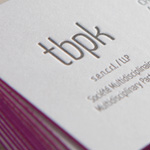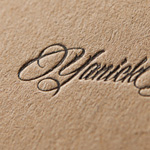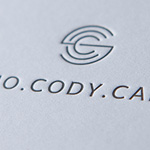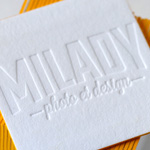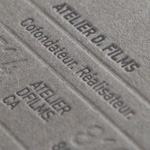
LETTERPRESS PRINTING
Letterpress is a printing process that dates back to the mid-15th century. Most letterpress printing presses are large cast iron machines operated by hand. The engraved artwork is inked and then pressed onto paper to create a debossed image. Each piece becomes a work of art that engage the senses and communicates an elegance and handcrafted quality that can’t be matched by any other printing method. Our letterpress cards are individually hand printed on our old 1878 platen press.
Shop here for letterpress business cards.
LETTERPRESS VS DEBOSSING
Debossing is different from letterpress printing. Debossing is a process that makes an indented text or image in the paper. This process doesn't involve ink. Sometimes, a debossing is applied to a printed image to imitate letterpress. Debossing involves a separate stage in the production process, after printing and trimming. Because it requires a separate press run, a tolerance of 1/64 inch is standard for registration of deboss to printing graphic. In other words, it means the indent may not be perfectly aligned with the printed image. Standard offset printing with debossing is usually a less expensive alternative to letterpress.
Letterpress involves ink. When the inked plate is pressed in the paper, a debossed effect is created in the process. This ensures a perfect alignment every time. A blind impression is possible without the use of ink. Be aware that letterpress printing is not suitable for every projects and artworks. Cost can be much higher and there are some limitations to consider with traditional letterpress printing.
LIMITATIONS AND CONSIDERATIONS
- Color and imprint has variations from piece to piece because of the manual nature of letterpress printing.
- Colors are printed one at a time. Letterpress is great for 1 or 2 color jobs. Pantones only, no CMYK.
- Letterpress is meant to be used for minimal ink coverage. Large solid areas are far from ideal.
- Depth of impression can vary depending on the image coverage and the paper selection.
- No halftones, no gradients, no photos. Solid colors only.
- Vector or high quality tiff files only. No JPEGs please.
- Width of lines must be a minimum of 0.25pt.
- 6pt sans serif minimum font size. Reverse type minimum font size is 12pt or it can clog up.
